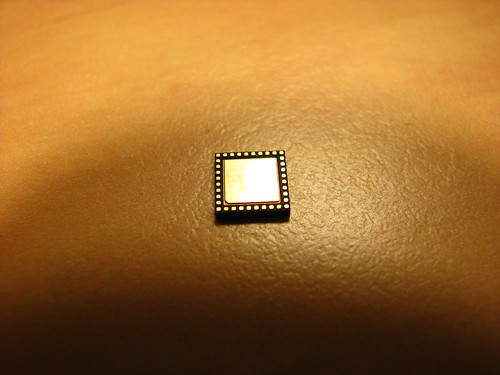Microchipping may sound like an extravagant pet indulgence––akin to gourmet birthday cakes and knit sweaters––but it is actually a practical and increasingly common precaution taken by pet owners throughout the world. Contrary to some misconceptions, pet microchipping is not intended to replace traditional collars and tags. Nor is it painful or harmful for animals. And it is not only for dogs. In fact, microchips can be implanted in a wide range of pets, and are responsible for the rescue of tens of thousands of beloved animals throughout the world each year.
What is Microchipping?

credit: fdecomite
Despite the high-tech sounding name, microchipping is actually quite simple. A tiny chip, only slightly larger than a grain of rice is injected into the animal, under the skin between the shoulder blades (the implanting process is only slightly more painful than an ordinary injection). The chip is covered in biocompatible glass and coated in a special compound called Parylene C, designed to promote natural tissue growth. This means the chip wont migrate or harm the animal’s body in any way.
Pet microchips are guaranteed for life, and the practice of microchipping has been in use for more than two decades. The chips emit a harmless radio frequency to enable detection, and are encoded with a unique ID tag, which corresponds to the owners’ information in a large database. The process is also relatively cheap. Pet owners pay a small fee for the injection and another small one-time membership fee for registration in the database. Though only about 5% of pets in the USA are currently microchipped, nearly a quarter of all UK pets are chipped, and the practice is rapidly gaining popularity around the world. The chips are currently available for cats, dogs, rabbits, and ferrets.
Why Should I Get My Pet Microchipped?

credit: idleformat
Every year, millions of unidentified and unclaimed pets are euthanized in animal shelters. As unique breeds become increasingly expensive, criminal dognapping is on the rise. Unfortunately, no matter how diligent a pet owner you are, there is never any guarantee your pet wont get lost, stolen, inadvertently let loose, or fall victim to unforeseeable circumstances. Natural disasters such as floods and earthquakes, for example, often result in thousands of displaced pets.
With traditional tags and collars, pet recovery depends upon the act of a Good Samaritan, and distraught owners have few options. Pets often slip free from their collars, too, in which case chances become slim of their ever reaching home again. But microchipping offers an excellent solution: chips can’t be slipped out of and allow owners to track down their animals almost immediately. Microchipped pets are much more likely to be found and reunited with their owners when they go missing.
Of course, the decision to invest in microchipping is a personal one that each pet owner will need to make for themselves. Though many see it as a great safety precaution, others still have serious reservations about the practice. Whatever your decision, it pays to know the facts, risks, and benefits. Hopefully this article has helped!
Attached Images:
- License: Creative Commons image source
- License: Creative Commons image source
This article has been contributed by Invisible Fence® Brand, specialists in electronic pet containment systems.










Comments